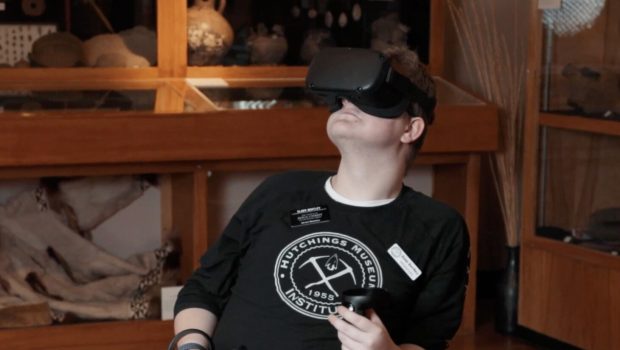Service missionary with spina bifida uses VR technology to explore a cave
A Latter-day Saint service missionary with spina bifida recently explored a cave in Utah while seated comfortably in his wheelchair.
The expedition, a first for Elder Gage Bentley, was made possible thanks to virtual reality technology.
“It was very realistic,” the 20-year-old said in a news release. “I thought I was actually in the cave while I had the headset on.”
Elder Bentley is helping to develop VR experiences to increase accessibility to things some people might not normally experience as part of his assignment as a service missionary for The Church of Jesus Christ of Latter-day Saints at Hutchings Museum Institute in Lehi, Utah.
What are service missions?
Elder Bentley is one of more than a dozen of Latter-day Saint service missionaries serving at Hutchings Museum Institute. His other assignments include helping to care for animals in the museum’s live animal room and working with the marketing team to manage the website.
Worthy young men and women, ages 18-25, who are unable to serve a teaching mission for physical, mental, emotional or other reasons may be called to a service mission. They live at home and serve locally under the ecclesiastical direction of their stake president.
Service missions can be tailored to a missionary’s unique talents, skills and abilities, offering opportunities to serve in approved charitable organizations, church operations and other stake-assigned service opportunities, according to ChurchofJesusChrist.org.
There are more than 2,000 service missionaries currently serving worldwide, according to the church’s newsroom.
Cave explorations using VR technology
Hutchings staff members recently carried equipment into Indian Cave, a cavern in the Lehi foothills, to create a detailed virtual experience. Elder Bentley was unable to go personally but still felt the experience of seeing and climbing inside the cave by using virtual reality technology.
Hutchings produced a YouTube video to capture his experience.
“I actually wondered if it would be as real as I imagined the cave being, but it was quite real,” Elder Bentley said. “With VR there’s so much that you can do to help people who are disabled or who are unable to come to specific locations or see those parts of Utah they just normally would not be able to see.
“With Indian Cave,” he continued, “I was able to just look at the VR and walk about in the video that is on the museum’s website and just sort of explore around. You wear the VR and with hand controls it’s like you’re right there.”
Hutchings is embracing new technologies like this to create and provide more accessible experiences for people with disabilities and limitations, said Daniela Larson, the institute’s executive director.
“The technology allows us to provide an experience that’s very similar to the real thing,” she said. “Additionally, some virtual reality experiences allow more than one person to participate so you can actually share the experience with your friends.”
Will VR technology be a game-changer for people with disabilities? Elder Bentley says it depends on the person, but he’s ready to virtually explore more outdoor locations in Utah. He’s made a list for the Hutchings VR team.
“With VR you’re able to see a different perspective — a different point of view,” he said. “Now we’re able to be in the cave, in the Narrows, or at Zion’s through the power of technology.”
Elder Gage Bentley is helping to develop virtual reality technology at the Hutchings Museum Institute as part of his assignment as a Latter-day Saint service missionary.
Hutchings Museum Institute








Gloss